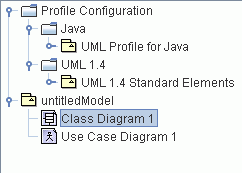Table of Contents
![[Caution]](images/caution.png) | Caution |
|---|---|
This section used to be called "Built In DataTypes, Classes, Interfaces and Stereotypes", and has not been updated completely since the introduction of Profiles. |
This chapter describes ArgoUML's built in profiles, which contain datatypes, enumerations, classes, interfaces, stereotypes, tag definitions, and critics.
Datatypes, enumerations, classes and interfaces are generally available for use anywhere a class may be selected in the properties tab. The most common use is for return type and parameter types in method signatures.
Stereotypes and tag definitions are mostly used for application specific extensions of the model, e.g. to distinct elements that need to be implemented differently.
Critics are included with profiles to support safeguarding constraints specific to the profile's target application.
The model elements in an
UML profile are
organized as a hierarchy beneath a Model,
but they are not part of your project.
Hence, they are loaded separately, and once used,
they need to be present
with the project to be able to open it.
Next to the built in profiles, ArgoUML makes it possible to create your own profiles, or use profiles from a third party.
